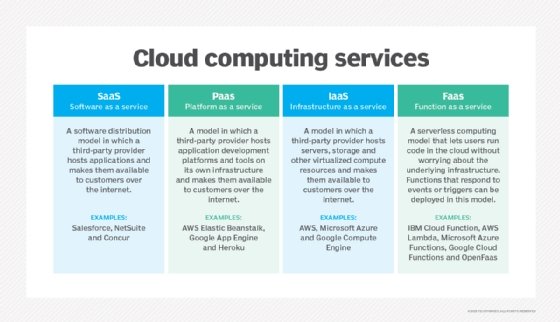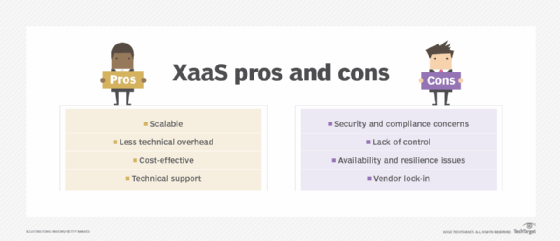XaaS (anything as a service)
What is XaaS (anything as a service)?
XaaS is a collective term that refers to the delivery of anything as a service. It encompasses the many products, tools and technologies that vendors deliver to users as a service over a network -- typically the internet -- as an alternative to providing them locally or on-site to an enterprise.
This umbrella term refers to service offerings that are accessed as needed and financed using a pay-as-you-go cloud computing pricing model. XaaS offerings can scale up or down as needed, letting a managed service provider deliver information technology services as needed.
XaaS vs. SaaS
Software as a service (SaaS) is an example of the as-a-service delivery model. SaaS and XaaS both refer to the delivery of a cloud computing service. They differ by degree of specificity:
- XaaS is the general term. There are many different types of XaaS deployment models, including software, platform and infrastructure services.
- SaaS specifically refers to a cloud-based software distribution model in which a cloud provider hosts applications and provides them as a service to users over the internet or other network.
Examples of XaaS
The most common examples of XaaS are the following:
- SaaS includes a range of applications, such as Google Apps, Microsoft Office 365 and Salesforce.
- Platform as a service (PaaS) providers deliver hardware and software tools to users over the internet. PaaS offerings, such as Amazon Web Services (AWS) Elastic Beanstalk, Apache Stratos, Google App Engine and Salesforce's Heroku and Salesforce Platform, typically provide preconfigured virtual machines and other resources for application development and testing.
- Infrastructure as a service (IaaS) is a model where a cloud provider provides IT infrastructure -- such as storage, server and networking resources -- over the internet to customers on a subscription basis. Examples of IaaS offerings include Amazon Elastic Compute Cloud, Google Compute Engine and Microsoft Azure.

There are many other examples of XaaS, including the following:
- Authentication as a service, or AaaS, uses cloud services for identity and access management.
- Containers as a service, or CaaS, enables the deployment and management of containers using container-based virtualization.
- Database as a service, or DBaaS, provides access to database platforms from public clouds providers such as AWS and Azure.
- Device as a service, or DaaS, encompasses third-party vendors that offer PCs, smartphones and other mobile computing devices as a paid service.
- Disaster recovery as a service, or DRaaS, lets cloud providers help organizations regain functionality after a disaster.
- Function as a service, or FaaS, helps cloud customers develop applications; deploy functionalities, such as microservices; and only incur charges when the functionality executes.
- Network as a service, or NaaS, is hosted network infrastructure provided by a third party.
- Storage as a service, or STaaS, provides application, data and backup storage systems in the cloud.
- Unified communications as a service, or UCaaS, is hosted software that provides communications and collaboration applications.
Benefits of XaaS
Some of the benefits of XaaS include the following:
- Cost-effective. Cloud service models can cut costs and streamline IT deployments. Using them, organizations can scale back IT infrastructure and provide on-demand services, deploying fewer servers, storage devices, network switches and software deployments in their data centers.
- Less environmental and staffing overhead. Using cloud-based services lets an organization reduce its physical overhead, such as space, power and cooling. Contracted services also enable IT staff to be reassigned to more important projects and business processes. For budgeting, the use of outside services rather than deploying on-premises technology shifts many capital expenditures to operational expenditures.
- Technical support. With XaaS, the third-party provider's staff provisions, maintains, upgrades and troubleshoots the service so customers don't have to deploy their own on-premises support personnel.
- Scalability. Cloud-based services can be scaled up or down easily depending on business needs.

Challenges of XaaS
XaaS can pose some business concerns and challenges:
- Resilience and internet reliability. It's important to be aware that disruptions, such as internet access problems, are a potential issue with XaaS.
- Visibility. Customers have limited visibility into and control over the service provider's environment and infrastructure.
- Vendor lock-in and dependence. Service providers can go out of business, be acquired, discontinue a service or alter features at any time.
- Security. If an MSP experiences a security breach, the user's data can be at risk.
- Hidden fees. Despite the convenience of the pay-as-you-go business model, XaaS users can incur hidden or unexpected costs when using a cloud provider's services.
How to implement XaaS
Implementing XaaS platforms requires planning and a game plan so business leaders can ensure their organizations and employees are open to adopting XaaS. The steps involved include the following:
- Define goals. Clearly articulate the scope of business requirements that XaaS platforms can fulfill and the extent to which these platforms play a role in operations.
- Develop migration strategy. It's likely that some in-house processes will shift to the XaaS provider. A comprehensive migration strategy that anticipates potential obstacles will ensure a smooth transition.
- Train employees. Employees must be on the same page and equipped with the skills needed to participate in the migration and subsequent use of XaaS tools.
- Communicate with stakeholders. Informing stakeholders to ensure they're on board with the migration to XaaS is necessary. The transition can have a profound effect on the organization.
- Identify suitable service providers. When choosing XaaS providers, it's important to consider factors such as ease of integration when implementing their platforms with existing infrastructure as well as their service-level agreements and disaster recovery options.
- Measure performance. The first step in an ongoing performance monitoring process is determining the criteria and metrics to use to measure XaaS success.
- Mitigate risks. Once XaaS systems are fully implemented, put in place plans to proactively mitigate risks and address downtime caused by issues such as power outages.
The future market for XaaS
The combination of cloud computing and ubiquitous, high-bandwidth, global internet access bodes well for XaaS growth. Signs from vendors and researchers point to continuing XaaS growth as customers bring more workloads into the cloud. The XaaS market is projected to grow to $3.2 trillion in 2030 from $700 billion in 2023, according to a Fortune Business Insight report.
Some organizations hesitate to adopt XaaS because of cybersecurity, compliance and governance concerns. However, service providers are increasingly addressing these issues.
The convergence of 5G, edge computing, big data, artificial intelligence, automation, machine learning and IoT have contributed to the XaaS model and the cloud in general. As businesses need to process more information, it becomes less economically feasible to host computing services on premises. This has led many to incorporate cloud platforms as part of their digital transformation.
One type of XaaS that has grown in recent years is backup as a service. Learn how businesses benefit from this type of XaaS.




